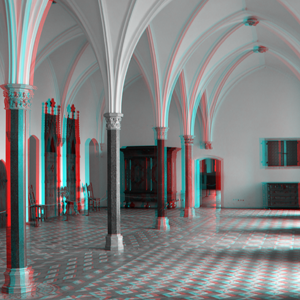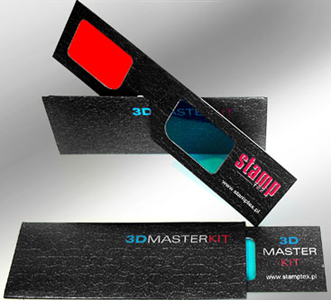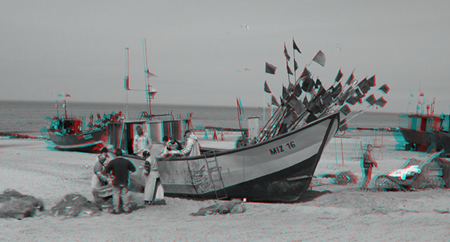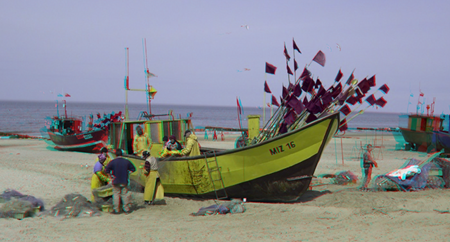5.2.3 Anaglyph method
White light consists of the combination of electromagnetic waves of all visible lengths - it was first described by Sir Isaac Newton in his “Optics” (1704). He discovered that a glass prism separates white light into a spectrum of colors and brings this spectrum together into white light again. The approximate wavelengths of spectral colors are given in Table 1.
Table 1. Approximate wavelengths of spectral colors
Range (nm) |
Color |
380 – 450 |
Violet |
450 – 490 |
Blue |
490 – 560 |
Green |
560 – 590 |
Yellow |
590 – 640 |
Orange |
640 – 730 |
Red |
The anaglyph method (from the Greek word anagliphos, meaning embossed) is based on adding complementary colors into images of a stereo pair. The colored images are shown(printed) as superimposed over each other. Red and cyan colors are used in most cases.It is convenient because these colors are located at the opposite sides of the spectrum what makes the separation of them rather easier. Besides, red, blue and green are primary colors, i.e. the combination of these colors can give us the rest of colors in the complementary model.
You can see an example of anaglyph image in Fig. 16. In those parts of the photo, where the brightness of both images is the same, white color of various brightness (gray, black) is seen; but in the parts with different brightness, you can see that additional colors are doubled. These doubling results from the difference in the images taken from different points and it creates three-dimensional effect.

Fig. 16. Monochromic anaglyph image of a stereo pair (source images from www.3dmasterkit.com by Piotr Nawracala)
The separation of the left and right images happens when viewing an anaglyph image through color glasses (Fig. 17).

Fig. 17. Glasses for viewing anaglyph photos (picture from www.stamptex.pl)
The red glass transmits light only with the red color wavelength and the blue glass transmits light only with the blue and green color wavelength. As a result, the left eye sees only the left image with red color added to it while the right eye sees only the right image with cyan color added to it. The brain processes the signals and creates a three-dimensional image.
There are methods of producing anaglyph images allowing nearly all of the original colors of source stereo pair to be kept. However, if there are bright red or bright blue (green)objects in source images, it may affect the correct separation of the stereo pair in a color anaglyph. As a result, these objects will make viewing the image uncomfortable. You can see three types of anaglyph images of one and the same stereo pair in Fig. 18: the monochrome anaglyph produces good stereo effect independently of the original colors,quasi-colored anaglyph also looks good, but flags and other red objects begin "catching your eye" in the colored anaglyph.

a) monochrome anaglyph

b) anaglyph with partially kept colors (quasi-colored)

c) colored anaglyph
Fig. 18. Three types of the anaglyph image (photos made by Piotr Nawracala)
Anaglyph method is good for demonstrating stereo images from the monitor screen because it uses the additive method of color forming. Polygraphic print of anaglyph images is a quite difficult task, because the principle of color forming is changed to the subtractive and there is no strict correspondence between the additive and subtractive color models.